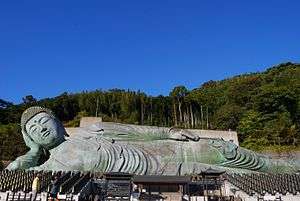Nanzoin temple
| Nanzo-in 南蔵院 | |
|---|---|
 | |
| Basic information | |
| Location | 1035, Sasaguri, Sasaguri-machi, Kasuya-gun, Fukuoka |
| Affiliation | Shingon |
| Country | Japan |
| Website | http://www.nanzoin.com/ (Japanese only) |
| Architectural description | |
| Founder | Hayashi Satoshiun |
| Completed | 1899 |
Nanzo-in Temple (南蔵院) is a Shingon sect Buddhist temple in Sasaguri, Fukuoka Prefecture, Japan. It notable for its bronze statue of a reclining Buddha, said to be the largest bronze statue in the world.
History
Nanzo-in temple was originally located on Mt. Koyasan, but local anti-Buddhist authorities threatened to destroy the temple in 1886. Public outcry lead to a decade-long effort to have the temple transferred to Sasaguri.[1] It was moved in 1899, under the leadership of Sasaguri priest, Hayashi Satoshiun.[2] Nanzo-in temple is the main location among the 88 temples that make up the Sasaguri pilgrimage route, one of the three famous walking pilgrimages in Japan.[3]
Today, the temple and its surrounding grounds receive more than 1 million visitors annually.[3]
Lottery
A chief priest of Nanzo-in temple once won the lottery after laying his ticket next to a statue of Daikoku. The temple claims that others who have made a similar effort have also won the lottery, bringing the temple associations with luck and lottery tickets.[4]
Reclining Buddha
The reclining Buddha statue, known as either Nehanzo or Shaka Nehan ("Nirvana")[5] is 41 meters long, 11 meters high, and weighs nearly 300 tons.[6] The statue depicts Buddha at the moment of death, or entrance into nirvana.[4]
The interior holds ashes of Buddha and two Buddhist adherents, Ananda and Maudgalyayana. Those relics were a gift from Myanmar as thanks for the sect's donations of medical supplies[4] to children in both Nepal and Myanmar.[2] In 1995, 1,300 monks from Myanmar and Nepal attended the unveiling of the reclining Buddha statue.[2]
Inside the sculpture, sand from each of the 88 shrines that make up the Shikoku pilgrimage are stored below bricks within a narrow hallway.[4][7]
Every year, hundreds of Buddhists come together to clean the statue using bamboo leaves tied to five-meter poles.[5]
Funerals
Nanzo-in Temple has 4,315 nokotsudo, places where bones of the deceased are stored.[8] The temple has a non-traditional fee structure for housing remains. First, it is open to all sects of Buddhism, and is even open to Shinto remains. Secondly, many Buddhist temples rely on a monthly fee for housing the bones of the deceased, which are then disposed of after a set period of time. Nanzo-in Temple has one fee, which covers 200 years.[8]
References
- ↑ ACROS, Fukuoka (2011). Fukuoka Guide Spring 2011. ACROS Fukuoka.
- 1 2 3 Kanko, Sasaguri. "Sasaguri Tourism: Nanzoin Temple (Japanese)". Sasagurikanko.com. Retrieved 9 December 2015.
- 1 2 Fukuoka, Crossroads. "Nanzoin Temple". Crossroads.
- 1 2 3 4 "Fukuoka's Great Buddhas" (PDF). Rainbow. 326. July 2013. Retrieved 9 December 2015.
|first1=missing|last1=in Authors list (help) - 1 2 "Karmic Cleansing". Macleans.ca. Retrieved 9 December 2015.
- ↑ Sasaguri-shi. Sasaguri Sight-Seeing Spots (PDF). Sasaguri Town.
- ↑ Nakamura, Connie. "Sasaguri Town - Mini Pilgrimage And More!". Taiken.co. Taiken. Retrieved 9 December 2015.
- 1 2 Bryant, Clifton (2003). Handbook of Death and Dying. SAGE. p. 668.
Coordinates: 33°37′11″N 130°34′23″E / 33.619839°N 130.572935°E